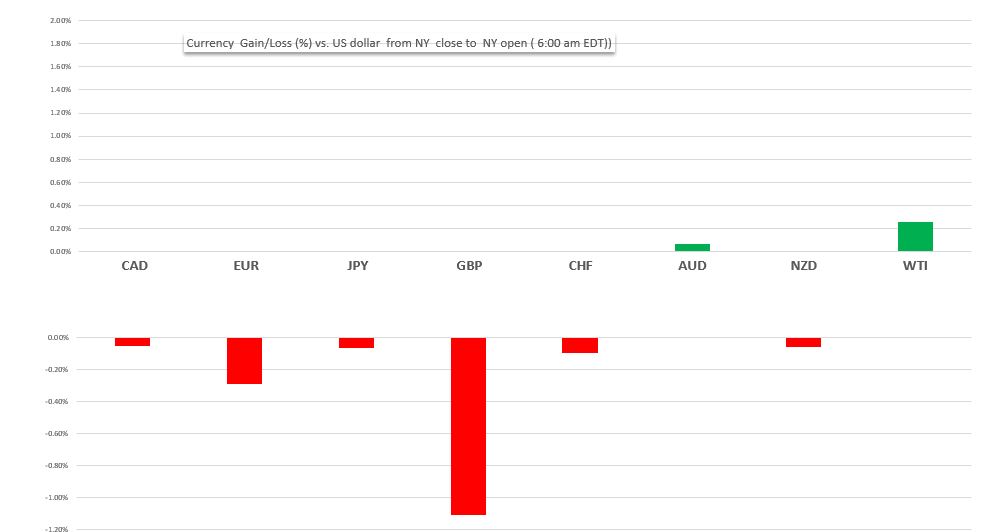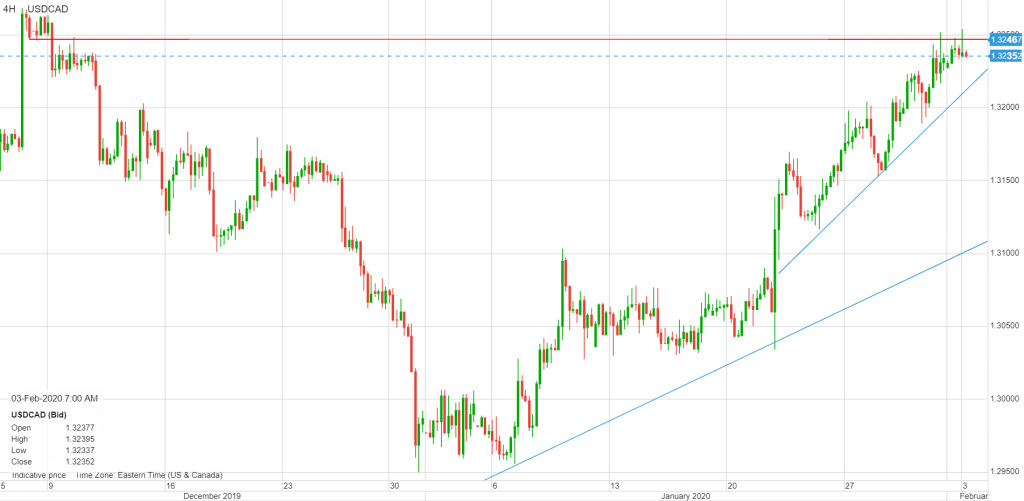
February 1, 2020
USDCAD open (6:00 am EST) 1.3241-45 Overnight Range 1.3233-1.3354
UK Prime Minister Boris Johnson hasn’t even started speaking about his outline for European Union trade talks, and traders didn’t like what they didn’t hear. GBPUSD dropped from Friday’s close of 1.3205 to 1.3150 in Asia, then accelerated down to 1.3056 by the New York open.
Chinese markets reopened after a long, Chinese New Year holiday. It was ugly. The Shanghai Shenzhen CSI 300 plunged 7.88%, and USDCNY soared. The PBoC acted to stem the panic, banning equity short-selling, and cutting 7 and 14 day repo rates.
China reported 17,205 confirmed coronavirus cases and the death toll rose to 361 as of Feb. 2
The US dollar opened on a firmer footing against the G-10 major currencies, led by a 1.11% drop in GBP from Friday’s close to Monday’s New York open.
Chart: Currency gain/loss(%) against the US dollar from NY close to NY open

Source: Saxo Bank/ IFXA Ltd
EURUSD traded lower in Asia and Europe, weighed down by broad US dollar moves and concern around the coronavirus impact on global growth. ECB official Luis de Guindos predicted Eurozone inflation would hover around current levels for 2020. He also said coronavirus created uncertainty. EURUSD technicals are bearish below 1.1110, looking for a retest of support at 1.0980. Traders ignored eurozone Manufacturing PMI data for January. (Actual 47.9 vs December 47.8)
GBPUSD is trading at its overnight low as PM Johnson speaks about trade negotiations with the EU. He said the UK wouldn’t insist the EU adopt all its rules so it makes sense that the EU should not expect the UK to follow all their rules. He also ruled out offering EU long-term assurances on fishing rights in UK waters. The intraday GBPUSD technicals are bearish below 1.3120 and looking for a retest of the October uptrend line that comes into play at 1.2980.
USDJPY inched higher overnight, rising from 108.32 to 108.69 before easing down to 108.51 in early New York trading. Prices are modestly supported by a mild downgrade of risk aversion after China’s reaction to stabilize its markets. US equity futures are slightly in the green suggesting a positive open on Wall Street, although that could change quickly. US Treasury yields clawed back some losses and are trading at 1.546%. The USDJPY uptrend from August is in place while prices are above 108.10.
AUDUSD and NZDUSD traded choppily albeit in narrow ranges and both currencies opened close to flat in New York. AUDUSD underperformed NZDUSD following mixed to soft economic data ahead to tomorrow’s RBA monetary policy meeting.
Oil prices dropped top $50.61/barrel at the Asia open. The drop was exacerbated by reports that China’s oil demand was down 20% and Sinopec reduced refinery capacity by 600,00 barrels/day. Prices rebounded to $51.95/b after rumours that Saudi Arabia was considering a temporary production cut of $1.0 million barrels per day.
USDCAD is supported by the drop in oil prices and the Bank of Canada’s shift to a dovish monetary policy stance. Resistance in the 1.3280 area was reinforced on Friday with the slightly better-than-expected December GDP result, which economists suggest keeps Q4 growth on track for a small gain.
US ISM Manufacturing PMI is expected to be 48.5, beating the 47.2 result in December and providing fresh support to the US dollar.
USDCAD Technical Outlook
The USDCAD technicals are bullish above 1.3110. There is a double top at 1.3260 which should provide resistance, ahead of 1.3330. A move below 1.3205 opens the door to further losses to 1.3150. For today, USDCAD support is at 1.3210 and 1.3180. Resistance is at 1.3260 and 1.3305. Today’s Range 1.3210-1.3290
Chart: USDCAD daily

Source: Saxo Bank





